r.i.p.
Archived Posts from this Category
Archived Posts from this Category
Posted by thomas-cummins on 04 Nov 2009 | Tagged as: r.i.p.
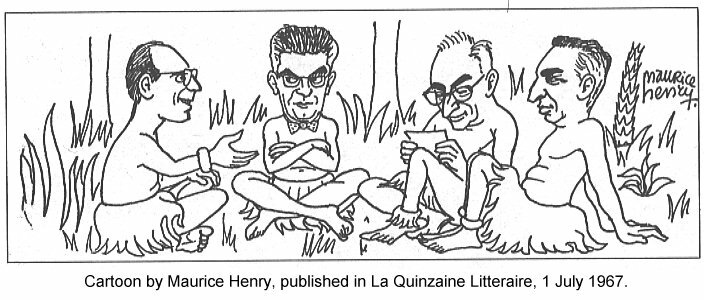
(from left to right) Foucault, Lacan, Levi-Strauss, and Barthes.
The recent passing of Claude Levi-Strauss (1908-2009) marks the end of an era as he was the last of the four great Structuralists (and Post-Structuralists) represented in the infamous cartoon “The Structuralists’ Lunch Party.” At a 100 years old, he outlived Foucault, Lacan, Barthes, and even the Deconstruction of Derrida.
Posted by thomas-cummins on 24 Oct 2009 | Tagged as: r.i.p., sneak peeks
With the busy weekend, you don’t necessarily have to go to Rayburn’s 1312 Wyoming studio to add some of his art to your collection. Instead, you can peruse the artworks at this website and then email your bid to . Just be sure to get your bid in before 4:30 p.m. this Sunday afternoon.
Posted by thomas-cummins on 29 Jul 2009 | Tagged as: celebrations, in yo face, performance art, r.i.p., renegade performances
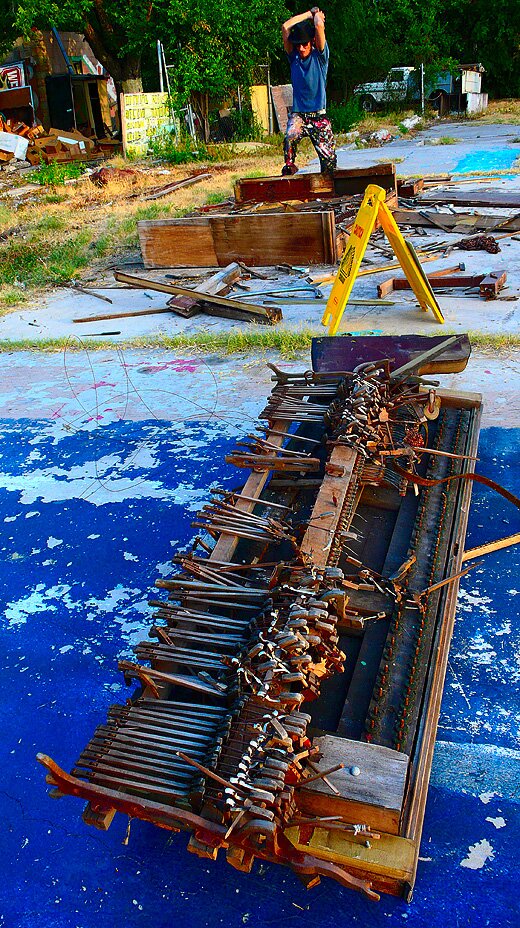
“ and Skye Cosby will be destroying a historic piano upon which music legends such as Sam Cooke have played. The piano was a gift from the late artist Reverend Seymour Perkins’ family to commemorate his artistic career and legacy. Perkins and Castellanos collaborated extensively for the last 2 years of Perkins’ life. Afterwards, Castellanos will build a wall sculpture out of the piano pieces…” -Raul’s MySpace
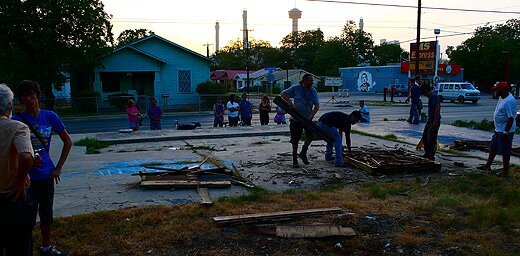
“My performance partner suffered a heat stroke last week cancelling our performance but we are now able to guarantee that on Tuesday the 28th, at 7:45 PM, at 602 Nevada (and Hackberry) at Reverend Seymour Perkins’ famous cement slab/sculpture garden, I, Raul Castellanos, will be breaking a piano given to me by the Perkins family to honor the late controversial and legendary artist from the Eastside. My assistant is Skye who is also Perkins’ only authorized biographer. I collaborated on many projects with Perkins for a bit more than 2 years and was truly honored to do so.” -Raul’s MySpace
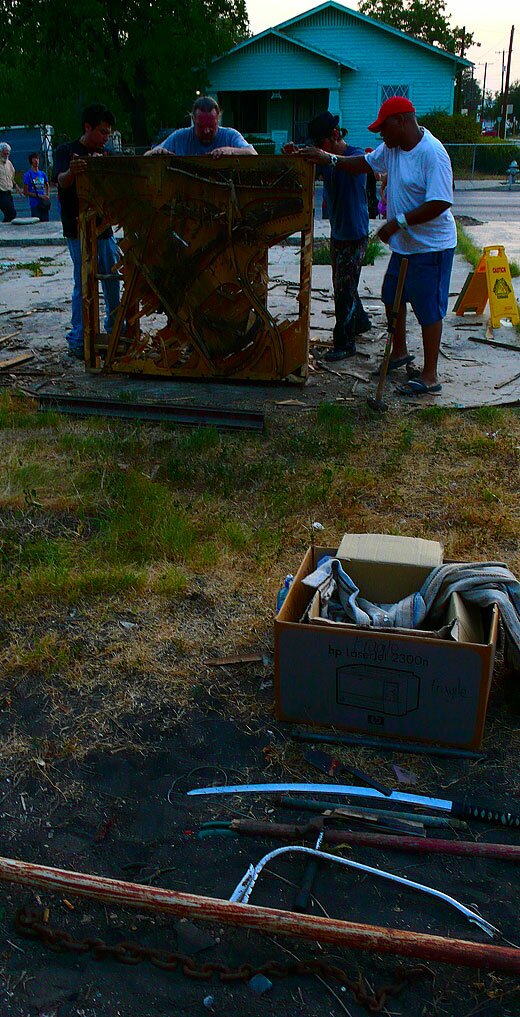
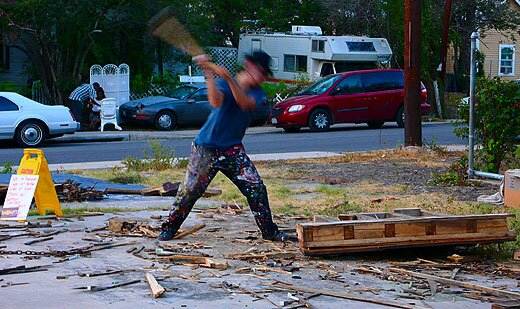
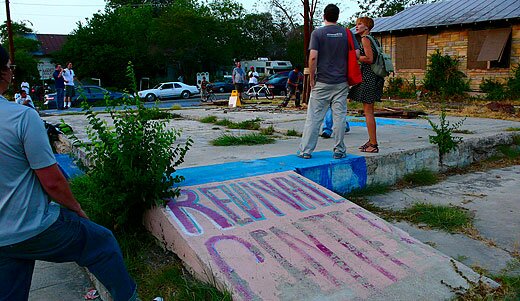
It’s hard to believe, but this event was actually as good as it sounded. Raul once had an art studio next to mine and he was always pretty intense- destroying perfectly good instruments to create paintings and sculptures that helped him represent his deafness to the world. Destroying this antique, though, seemed particularly irreverent as well as the fact that, this time, his chaotic artistic performance was taking place in the middle of one of San Antonio’s poorer black neighborhoods. For the most part, passing cars would just honk curiously at the gathering crowd. There were moments, though, when this art crowd might have felt they were on the wrong side of Sunset Station. One passing neighbor yelled at a nervous spectator and told him to put the piano back together. Overall, though, I felt a real sense of community built between artists, San Antonians, and the recently bereaved. It has often been said that in art- in order to create, you must destroy. What better place, then, than at the Reverend’s Revival Center which once strived to rebuild the tattered remains of strung-out lives.
UPDATE: A video of the event was just uploaded to .
Posted by ben on 20 Apr 2009 | Tagged as: architecture, arts organizations, celebrations, performance art, public art, r.i.p., video/film
When I was working on my first art review back in 2006, I saw a version of Edgar Arceneaux’s video “Old Man Hill” at the Artpace potluck that launched his residency there. The residency project (which later wound up in the Whitney Biennial) wasn’t as impressive as this simple homage to a man he never met: his father’s father. Arceneaux spelled out the only thing he ever knew about this man — that he was called “Old Man Hill” — in silver balloons, which hovered over the war-torn hills of Sarajevo. One by one the balloons released and twisted toward the sky. The cameras followed the balloons wistfully, clinging to these insubstantial forms seeking oblivion. Occasionally the cameras cut to people going about their lives in the city below, people looking away from these hills with their burned out buildings and piles of rubble.
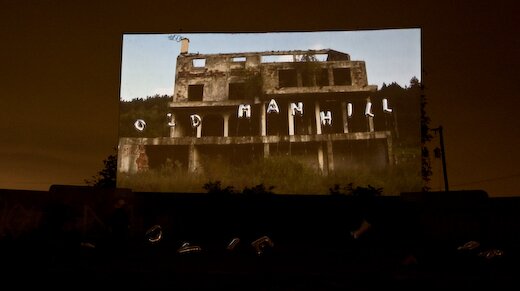
Linda Pace, who had not yet embarked on her battle with cancer, purchased this piece for her collection. Other than that potluck, the video had never been shown publicly; but before she died, Linda asked that it be screened at a special time, with the artist present. The Linda Pace Foundation arranged to screen the final version of this video for Linda’s birthday, last Thursday. Arceneaux was flown in to stage a performance along with the screening. The site selected for the project was the Mission Drive-In, a once-popular drive-in theater now dilapidated, graffiti-strewn, and slated for destruction. (It will be replaced with a new public library).
The evening of the event was overcast, windy, threatening rain. We got there early, and wandered around the old drive-in, its pavement giving way to grass, but its screens still fully intact. One by one, silver balloons were filled up and placed in front of the main screen, spelling out words that were unfamiliar to us, apparently a translation of “Old Man Hill” into Serbian Bosnian.
The translation of words hinted at another translation: the bombed-out hills of Sarajevo where snipers once found cover were translated into a theater in San Antonio, equally desolate, undergoing a wholly other kind of violence. This isn’t to equate the devestation of war to the disappearance of a drive-in, but to translate loss between cultures. Nearby the old theater, the Mission San Jose holds memories of a violence closer to that of Sarajevo: genocide, slavery, subjugation. But to most of us living in San Antonio today, the loss of place is felt more fully than the tragic, large-scale loss of life experienced by those who lived in Sarajevo in the 1990s or San Antonio in the 1700s. The slow erosion of the identities of our cities happens to be the kind of loss we are stuggling with now, the loss that we still don’t quite know how to grapple with.
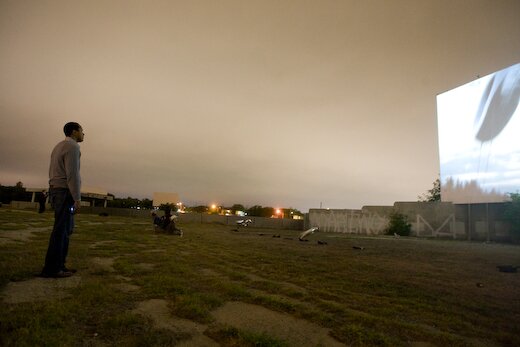
Eventually, as it grew dark, Arceneaux introduced the video, speaking of his search to learn something of his grandfather, a man neither he nor his father ever knew. This was a search to connect his identity to something larger, something more historically rooted. He spoke of his brief relationship with Linda Pace, who worked to create places in San Antonio that connect to what came before them: an old car dealership downtown becomes an artist residency space. This is the act of translating place — it doesn’t make sense to have car dealerships downtown anymore, but these spaces can be translated into something that is meaningful today, that turns loss and emptiness into another kind of value.
The video started, and as we watched Old Man Hill float away into the hills of Sarajevo, we also watched indecipherable words from another place float away into the San Antonio night, sometimes brushing slightly against the aging screen. And even as they disappeared from view, these words became embued with meaning. This was the final screening at the Mission Drive-In.
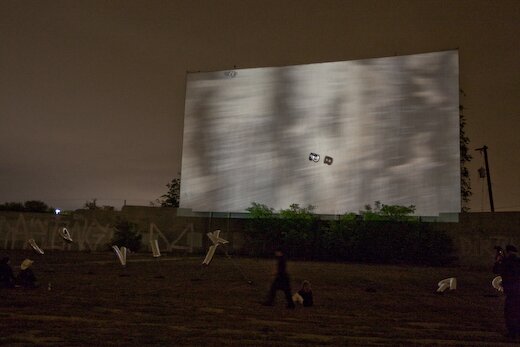
(Photos by Justin Parr, courtesy Linda Pace Foundation)
UPDATE: I’m honored to have Devin King respond to this in the second post on his new blog, Dancing Young Men From High Windows. Hopefully I’ll have time to respond to his post soon, but in the meantime I’ll point yall that way for an interesting reaction.
Posted by ben on 11 Feb 2009 | Tagged as: outsider, public art, r.i.p.
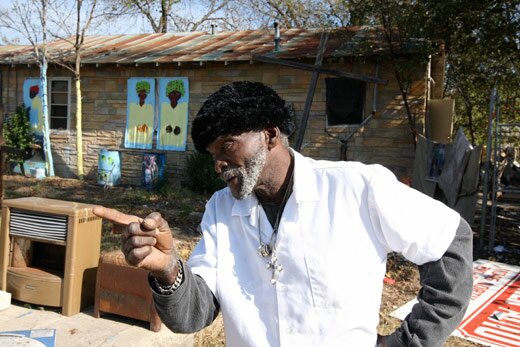
We have some very sad news to report: Rev Seymour Perkins, San Antonio’s outsider preacher-artist, has passed away. I’ve heard rumors he had cancer, but don’t have all the details. Emvergeoning wrote two long posts on Perkins, first as part of our San Antonio Outsiders series, and then a follow-up visit to document the work inside his home. I think the best place to see his work in person (since his house burned down) is the San Angel Folk Art Gallery.
[hat tip to ]
Posted by ben on 09 Feb 2009 | Tagged as: adventure day, public art, r.i.p., sound art
Last week I was surprised to learn of the passing of Max Neuhaus, and was a bit dismayed at the lack of coverage. The Houston Chronicle seemed to be the only paper covering the death of this important artist. But this morning I felt a bit better as the New York Times is out with their piece, and it’s a nice overview of his career.
Here, I thought I’d recount my first experience with a Neuhaus installation. I had been in New Hampshire to conduct the marriage of a good friend from college. On the way up, I learned of the death of my friend Alberto Mijangos, whose gallery I was running, and who in many senses had introduced me to art (I had attended his wedding in the Rothko Chapel at the age of five). Now I was headed back to San Antonio, a bit exhausted, trying not to think too much about this looming sadness.
My flight out of Manchester was delayed for hours. By the time it finally left, I had missed my connection in Newark, and the airline said it wasn’t their fault, so no hotel room. I decided not to pay for a hotel, to either sleep in the airport, or get in touch with a friend in the city. The one friend in New York I was able to reach was packing for a trip the next day, and didn’t have time for a visit. She helped me figure out how to get into Times Square, where I had heard there was a Max Neuhaus installation. By the time I made it into Times Square, it was about 11:30, still busy, but not too chaotic. I walked across the pedestrian islands until I heard a low ringing rumble flow up from the grates. As I stood there, transfixed in this invisible oasis, watching people and taxis wash over Broadway, I felt as if I was being enveloped by another world, which was really just an idea about perception. I rocked back and forth, listening as the sounds rippled and creased and rubbed, an infinitesimal percussion. Eventually, I made my way back the airport, and found a place on the floor to rest.
Posted by thomas-cummins on 06 Feb 2009 | Tagged as: r.i.p.

"Threads". Henry Rayburn. Linda Pace Foundation.
Posted by justin on 01 Feb 2009 | Tagged as: announcements, r.i.p.
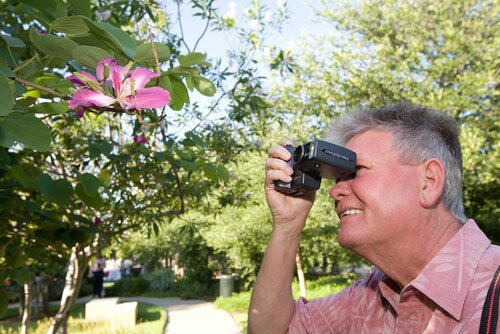
(Henry Rayburn shown at the Daniel Joseph Martinez event/opening at the Linda Pace Foundation last year. Photo by Justin Parr)
I will dearly miss seeing Henry out in San Antonio. More info here.
Posted by aaron on 28 Jan 2009 | Tagged as: music, performance art, r.i.p., vs.
I hope Ben doesn’t mind me borrowing his trademark vs. trope, but I couldn’t resist posting these images. Levitate over them for deeper enlightenment.
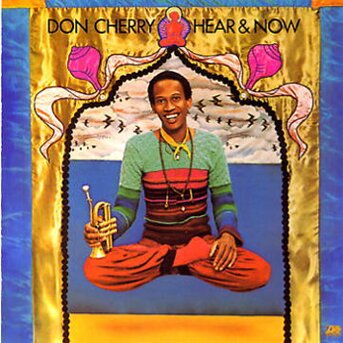
Pocket trumpet master and frequent Ornette Coleman collaborator Don Cherry.
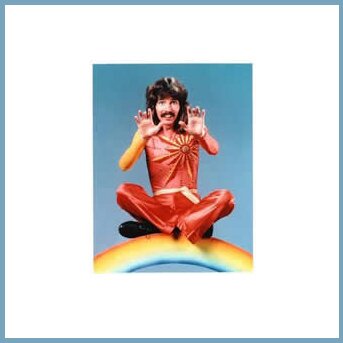
Magical TM devotee and 1970's teevee phenomenon Doug Henning.
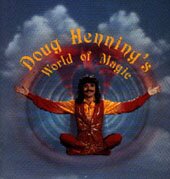
Bonus levitation.
Posted by ben on 15 Jan 2009 | Tagged as: r.i.p., tv

I’m very gratified because, when [The Prisoner] came out originally, in England, there were a lot of haters of it. A love/hate relationship, whichever way you look at it. Already there was a small cult. Now there’s a much bigger one over there. In fact, when the last episode came out in England, it had one of the largest viewing audiences, they tell me, ever over there, because everyone wanted to know who No. 1 was, because they thought it would be a “James Bond” type of No. 1. When they did finally see it, there was a near-riot and I was going to be lynched. And I had to go into hiding in the mountains for two weeks, until things calmed down. That’s really true!…
I wanted to have controversy, argument, fights, discussions, people in anger waving fist in my face saying, “How dare you? Why don’t you do more ‘Secret Agents’ that we can understand?” I was delighted with that reaction. I think it’s a very good one. That was the intention of the exercise….
— Patrick McGoohan, creator and star of The Prisoner, who died Tuesday
You can watch all 17 episodes of The Prisoner on the AMC website. The full Troyer interview (from which the quote above was taken) is transcribed here with .
Posted by aaron on 14 Jan 2009 | Tagged as: arts organizations, essays, in yo face, music, mustaches, possibilities, public art, r.i.p., rock!, wordy
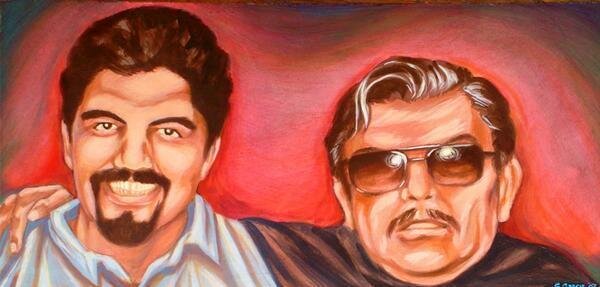
Manuel Diosdado Castillo, Jr. tragically succumbed to lung cancer on January 6th at the age of 40 – a matter of weeks after receiving the diagnosis – leaving behind a remarkable legacy of music, public artwork, of pride in and a powerful sense of responsibility for his beloved Westside San Antonio barrio. Manny was, for nearly twenty years, a singular presence in both the underground music scene in San Antonio (whose spiritual epicenter is marked by the centuries-old live oak tree at his favorite local dive/venue: the legendary, much-missed Tacoland) and in the non-profit community organization he built, originally as an offshoot project of Patti & Rod Radle’s Inner City Development, but which quickly blossomed into San Anto Cultural Arts.
My friendship with Manny goes back to a spontaneous garage rehearsal circa 1991. Marshall Gause and I were fruitlessly waiting at my folks’ house for some now forgotten drummer we wanted to try out, as our last band line-up hadn’t worked out. Marshall suggested trying to get in touch with this guy he had played a couple of times with the year before – they had enjoyed it, but it didn’t go anywhere as Manny soon left for New Orleans to follow Academic Pursuits. Marshall had a hunch he might be back in town now. After a few calls, the hunch was confirmed and we had a drummer on the way.
That first rehearsal (guitar, bass, & drums – singer Terry Brown had to work) immediately revealed an undeniable chemistry between Marshall’s hippy-punk musicologist guitar explorations, my intuitive but rudimentary bass playing (which, lucky for me, sounded better than it had much right to thanks to my chronic music obsession, a plethora of interesting audio exposure at a job selling used records, and especially Marshall’s unpretentious ability to cover for my lack of formal musical knowledge,) and Manny’s balls-out, hit-the-drums-hard-enough-to-break-at-least-one-head-per-session-but-always-dead-on-the-beat style, using complex rhythms even formally trained jazz drummers wouldn’t have the nerve to try. He was, and remains, one of the fastest, most precise drummers I have ever seen (even faster when he was nervous,) augmented by the physical strength to just bash the hell out of his drums – a steamroller cross between John Bonham, Neil Peart, Mitch Mitchell, George Hurley and Elvin Jones. All on a minimal and creaky drum set usually somehow held together with yarn.
That afternoon we quickly bonded musically over our mutual love for Rush, The Plugz, Esteban Jordan, Thin Lizzy and especially The Minutemen. Spontaneous jams we engaged in that day became the basis for numerous songs later fully developed and forming the initial base of our oeuvre (some still included in the set list at the time the band imploded.) In short order, we brought Terry back into the circle, sat around with some Lone Stars or whatever was cheap that day and soon agreed to call ourself El Santo, in homage to the legendary Mexican lucha enmascarada/film star who never lost a match.
Posted by ben on 13 Jan 2009 | Tagged as: art paparazzi, music, party photos, public art, r.i.p.
A few photos of Manny Castillo’s casket being painted by his friends and colleagues in the local art community:
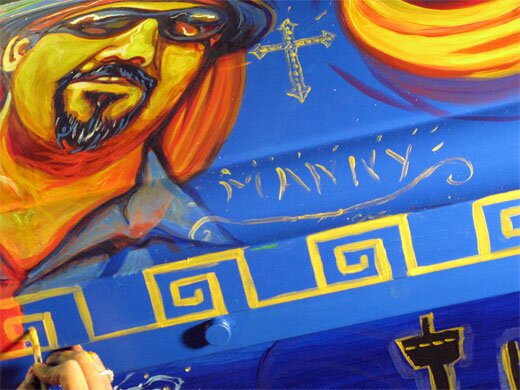
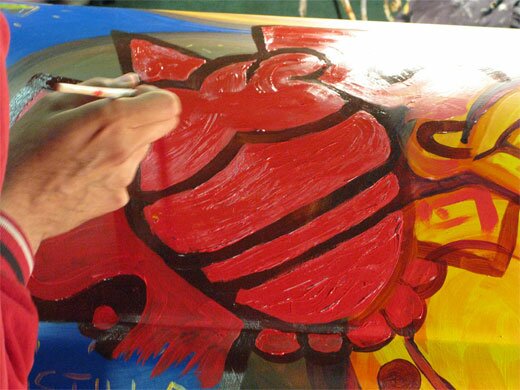

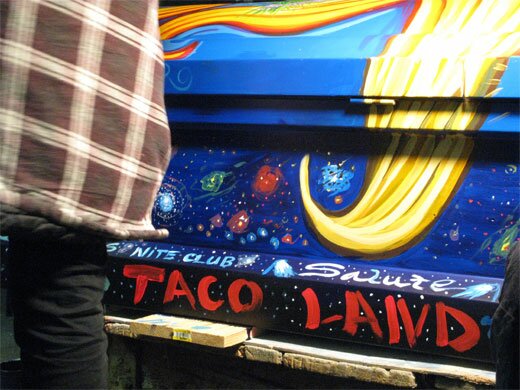
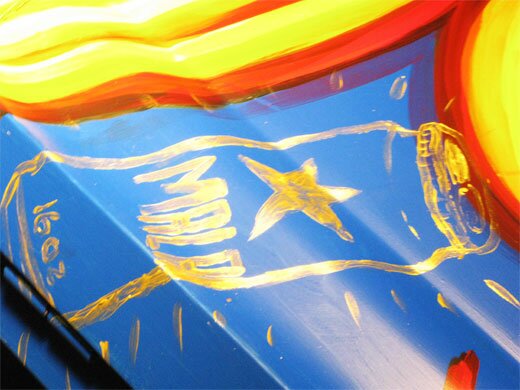
See also: San Antonio Express-News blog post with a number of murals facilitated by Castillo’s San Anto Cultural Arts; the Express-News obit; the San Antonio Current’s just before his death.
Posted by ben on 15 Dec 2008 | Tagged as: performance art, poetry, r.i.p., wordy
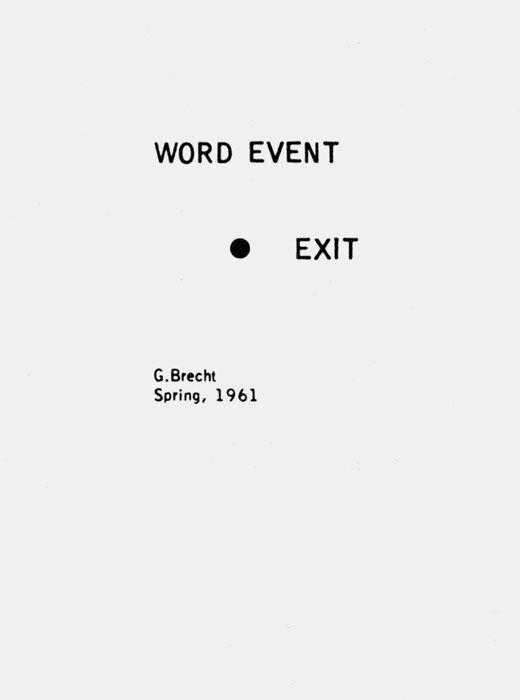
Word Event (George Brecht, 1961)
In their use of language as a device to cut into the evanescent everyday, [George] Brecht’s “insignificant and silly gestures” open an infinite universe of possibilities, just as [La Monte] Young’s precise operations move into the zones of the minimal and the series, of the same but inevitably different because virtually interminably—the line or the sound would go on in some sense “forever.” In both, the event is pared down to a minimum: a simple, basic structure that can be endlessly reenacted and reinscribed in new contexts, different in each instance and yet retaining a certain coherence. Inevitably calling to mind Lawrence Weiner’s highly condensed and yet generalizable “statements,” Brecht’s and Young’s most interesting scores reduce language to a kind of object, but also establish it as a kind of repeatable, replaceable structure, open to unlimited, unforeseeable realizations.
— Liz Kotz,
Posted by justin on 05 Nov 2008 | Tagged as: announcements, art paparazzi, outsider, r.i.p.
Found out via Mark Jones at the Halloween Bike Ride that Herb Hornung, the owner of the Wooden Nickle Museum, and creator/inventor of both full and single color double sided wooden nickle presses, passed away on Oct 20, 2008. I had the opportunity to meet and photograph him a few months back for a story done by the San Antonio Current. I really enjoyed my short visit with him that day, and came away with a wonder and newfound respect for a man who would build mechanized wooden nickles printing presses from scratch. I was only allowed to photograph one of the working presses, as he said that design was widely known, his full color machines were, and still remain to be, top secret.
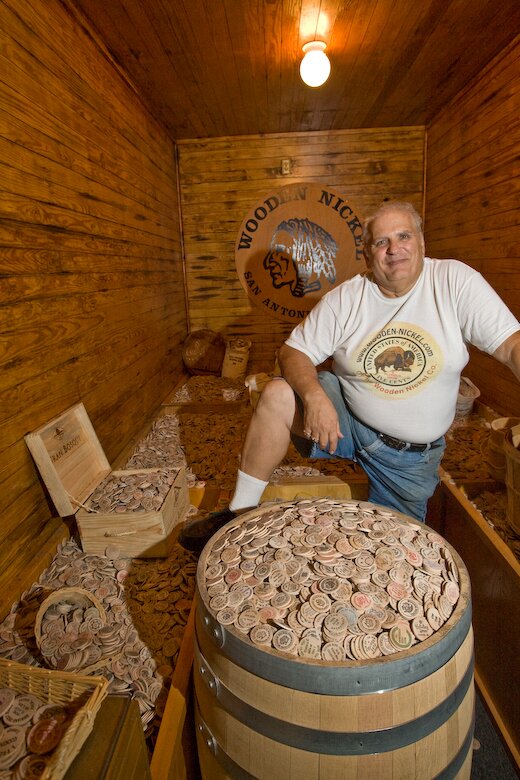
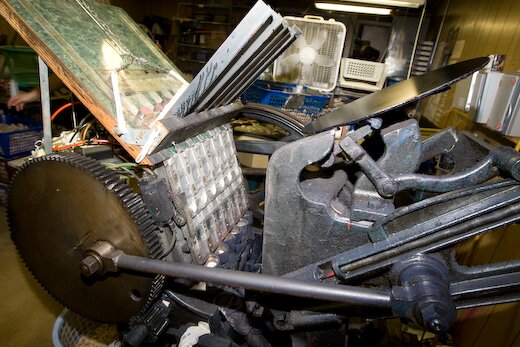
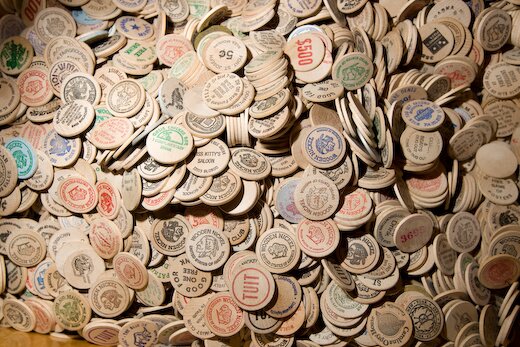
Posted by ben on 03 Nov 2008 | Tagged as: party photos, photography, r.i.p.
From Franco Mondini-Ruiz’s lavish Dia de los Muertos party at his westside wonderland estate, a cake for Mr Danny Geisler:

[Cross-posted at Scattered Work]
Posted by ben on 10 Jul 2008 | Tagged as: music, performance art, r.i.p., rock!, video/film
I just learned that Bruce Connor died on Tuesday. Here’s a wonderful little film he made in 1966 featuring the dancing of Toni Basil (aka Antonia Christina Basilotta) and the music of Ed Cobb (NSFW — there are a few nude shots):
Posted by ben on 19 May 2008 | Tagged as: r.i.p., responses/reviews

I decided not to post on the death of Robert Rauschenberg because I figured everyone else would. (That’s the attitude that has led to me posting only twice in the last three weeks. Sorry about that, folks.) But I would like to draw your attention to Tyler Green’s post on arts writers all over the country eliding Rauschenberg’s homosexuality, despite its centrality to his work.
Posted by justin on 29 Apr 2008 | Tagged as: acquisitions, r.i.p.
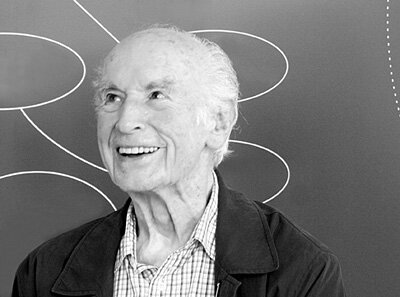
(Photo : Stefan Pangritz)
This morning I woke up around 8:30 am, slightly restless and uneasy. I sat on my bed for about an hour and read a chapter out of Andrew Weil’s “From Chocolate to Morphine,” which just happened to have fallen out of my bookshelf over the King William Fair. It happened to be that the page I turned to was the one detailing how Albert Hofmann had first discovered LSD-25 in 1938. I read the whole story on Albert and continued throughout my day. At several points today small snippets of what I read came back to “bite,” me so to speak within my normal everyday conversations. This was driven even further home by a headline I saw that popped up onto my home page just now signing in to check my email. “LSD Creator Albert Hofmann dies at 102,” it said. The biggest shiver ran down my spine. I don’t normally catch up on drug history in the morning, and I certainly don’t expect my catching up to echo current events. heres a link to an obituary in the UK Telegraph about the man and his accomplishments and beliefs. (more info – NYTimes)
Posted by justin on 20 Jan 2008 | Tagged as: adventure day, art paparazzi, celebrity sightings, performance art, possibilities, r.i.p.
exhibit a : Audio from Karen Mahaffy describing the execution.
exhibit b :
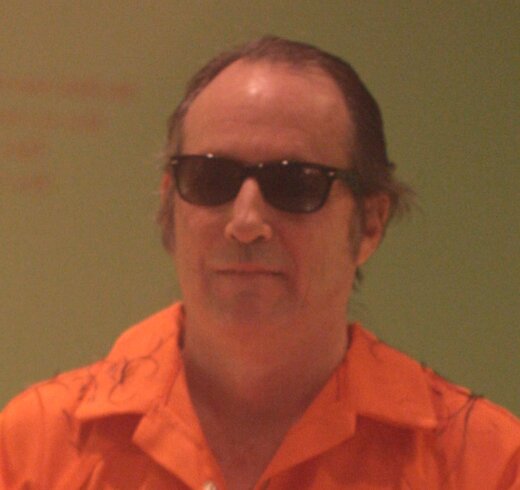
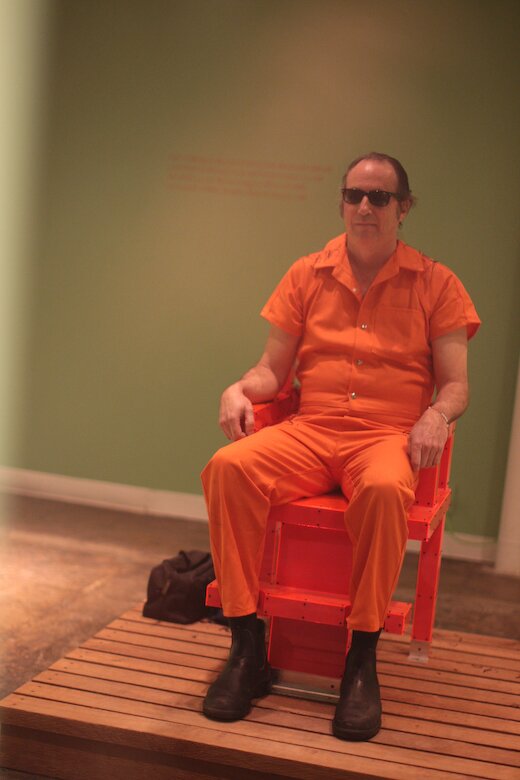
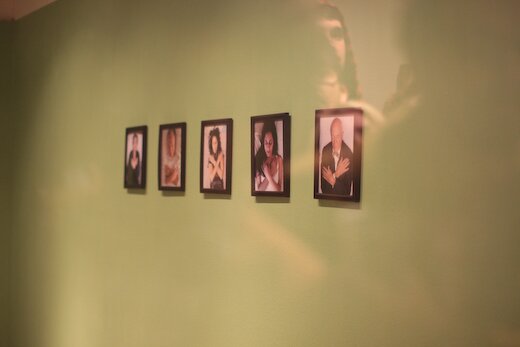
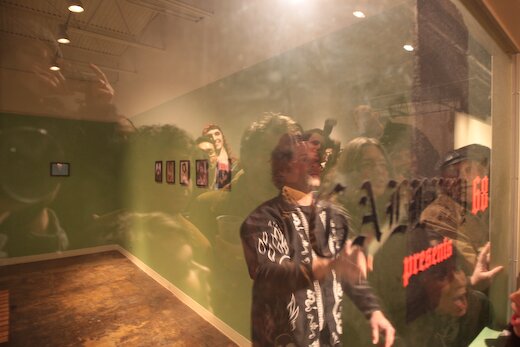
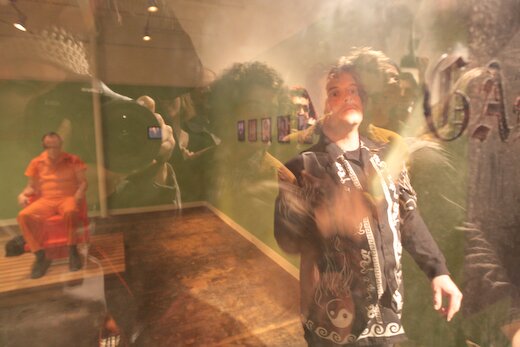
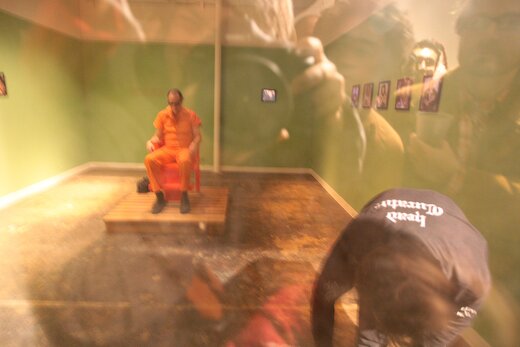
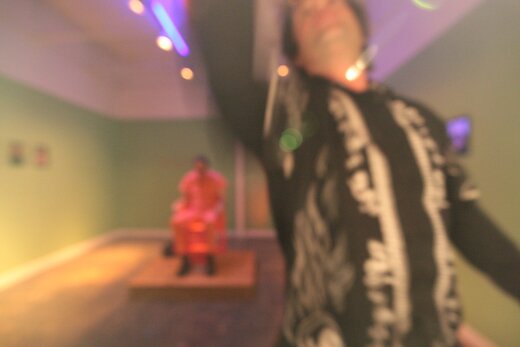
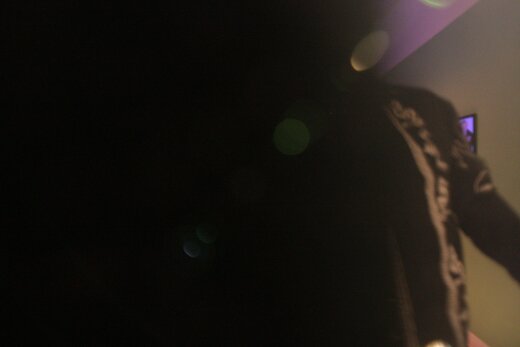

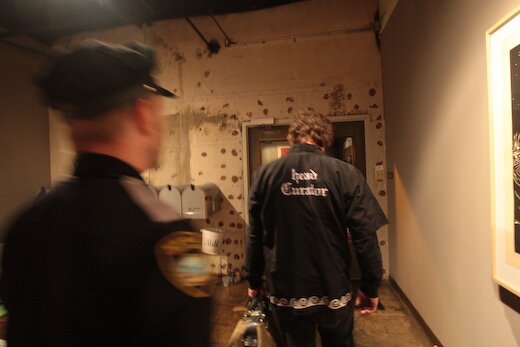
(photos copyright Justin Parr 2008)
INTRODUCING NEW EVIDENCE:
exhibit c : futureWorkerGirl reflects on artist as murderer, victim, pimp and ho.
Posted by justin on 05 Jan 2008 | Tagged as: adventure day, art + bikes, art paparazzi, graffiti, in yo face, possibilities, r.i.p.
(words: Aaron Forland, photos: Justin Parr)
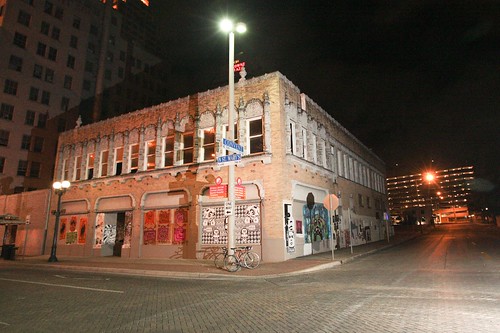
Who would have thought the day would come when the mighty Emvergeoning machine would get scooped on its home turf by a little-known upstart lowbrow/street art magazine called Juxtapoz? Not only that, but with photos we took, documenting a one-of-a-kind, one-night-only (thanks to our crack City maintenance crews – good lookin’ out, fellas) extralegal public art installation coordinated and executed by a group calling itself Uniting Artists Through Crime. Word has it that Scotch! and co-conspirators utilized the awesome networking power of to pull off this small coup. The diverse international show was mounted (after a false start one week prior) during daytime hours Monday, December 17th on the defunct, boarded-up former haven for the transient on North Saint Marys at Convent, directly across from our beautiful Greyhound Bus Station. As the press release (which also contained the magic word emerging) stated, the show ran “until the buff,” which, as mentioned, went down the following day. Fortunately, Fl!ght World Headquarters received a telephone tip late Monday night and we were able to semi-thoroughly document it in the wee morning hours.
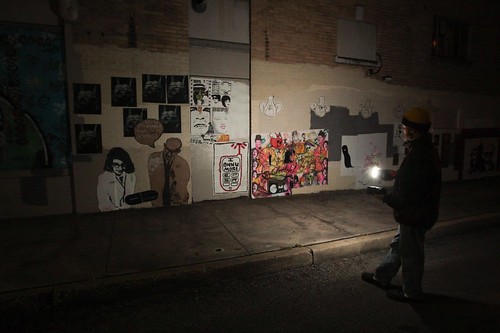
The show featured the work of artists from four continents, and may be the largest wheatpaste-based collaborative installation ever mounted in Texas. Standout works came from (Florida), New York City’s stencil-mad Bot, the sociopolitical stylings of (Malaysia), and San Antonio’s own fevered x-acto imagists and . Other contributing artists included (Califas), Aphro (SA), Bomit (Houston), Chis La Notte (Madrid, España), Dual (Houston), Dwell/Oneunit (NYC), Enosh (Califas), Enos One (SA), Genevieve (SA), (Queensland, Australia), Give Up (Houston), (SA), REPS/EPSR (SA), Washer (DC), Wes (SA) and probably a few others (apologies to anyone left out – I did my best to ID you all.) Media varied from traditional wheatpaste methods of xeroxed, screened or stenciled paper to hand-painted pieces and even stenciled metal plates.
Here you will find the entirety of Justin’s photos, and here are some supplementary celly snaps I took attempting to show a little more detail.
Posted by ben on 08 Dec 2007 | Tagged as: essays, music, r.i.p., responses/reviews, sound art
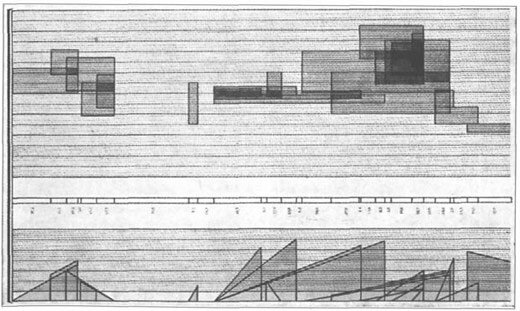
On the news of Stockhausen’s death, it may be worth reading this long essay on his work, which is still often misunderstood. This brief quote encapsulates some of the main ideas of the essay (by Jean-Claude Eloy):
The splendid success of the overall conception, general organization and production of “Zyklus” still do not always allow for the percussions to truly express their life and demonstrate all of their rich potential. On this matter, a work such as “Mikrophonie I” opens up surprising vistas and breaks down all barriers. The rich, but single, source for the whole work (the large tam-tam) is allowed ample time to “share” its multiple metamorphoses of tones, attacks, and resonances. Once again, with such a work, Stockhausen has shown himself to be a frontrunner, the boldest of all.
Throughout his work, Stockhausen’s dialectical personality is express by this double thrust, one rotating, the other ascending. One the one hand, he is truly audacious in his conceptual work and he knows how to impose a (sometimes “abstract”) form of thinking on musical material. And on the other hand, he possesses a very open sensitivity that studies material, listens to sounds created in the studio, analyzes their hidden pulsations, all to extract new meaning, go a step further and push the material forward.
Stockhausen’s double success in the two worlds of instrumental and vocal music – sound material that is already laden with history and acquired habits – as in the new realm of exploration of electro-acoustic technologies (a unique case in our times), can be understood by the presence of this dialectic that is constantly criss-crossing and circulating between two poles: from conception to material and from material to conception. Although ostensibly contradictory, these two poles are, in fact, complementary.
[Image above is a page from the score of Stockhausen's 1954 composition Studie II]
UPDATE: I decided to upload an MP3 of Stockhausen’s groundbreaking 1956 composition, Gesang der Junglinge. You can read more about this piece here. Enjoy.